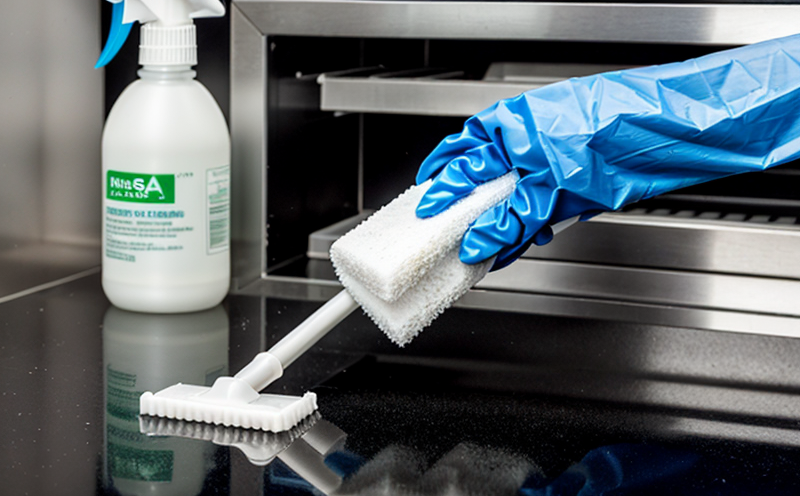DIN EN 13697 Microbiocidal Testing of Plastic Hygiene Surfaces
The DIN EN 13697 standard is specifically designed to evaluate the microbiocidal efficiency of plastic hygiene surfaces. This test is critical in ensuring that materials used in healthcare, food processing, and personal care sectors meet stringent hygiene requirements.
Microbiocidal testing assesses a material's ability to reduce or eliminate microorganisms on its surface through direct contact. The standard outlines rigorous procedures to simulate real-world conditions under which plastic surfaces are exposed to various pathogens. Compliance with DIN EN 13697 is essential for manufacturers aiming to produce safe and effective hygiene products.
Testing involves exposing the specimen to a defined inoculum of microorganisms, followed by incubation periods to allow growth. The efficacy of the material in reducing microbial populations is then quantified using culture-based methods or molecular techniques like PCR. This approach ensures that even trace levels of harmful pathogens are detected.
The standard also emphasizes the importance of proper specimen preparation and handling throughout the testing process. Specimens must be representative of actual products, with appropriate geometries and dimensions. Pre-treatment steps such as cleaning and drying are outlined to ensure consistent results across different materials.
Instrumentation plays a crucial role in this test, requiring high-precision equipment capable of accurately measuring microbial loads before and after exposure. Commonly used devices include automated colony counters, spectrophotometers for turbidity measurements, and real-time PCR machines for pathogen quantification.
The results from DIN EN 13697 testing provide manufacturers with critical data on the microbiocidal performance of their products. These insights are invaluable in optimizing product formulations, improving manufacturing processes, and enhancing overall hygiene standards. Additionally, compliance with this standard can significantly enhance a company's market reputation, particularly in competitive sectors like healthcare and food safety.
- Ensures adherence to international hygiene regulations
- Safeguards against microbial contamination risks
- Facilitates product development by identifying effective materials
- Promotes transparency in communication with regulatory bodies and consumers
Scope and Methodology
The DIN EN 13697 standard covers the microbiocidal testing of plastic materials intended for use as hygiene surfaces. This includes items such as flooring, worktops, medical equipment, and personal care products that come into direct contact with human skin or foodstuffs.
The scope is broad enough to accommodate various types of plastics but focuses on those used in environments where hygiene is paramount. The methodology specifies the steps required to conduct a thorough evaluation, from specimen preparation to final analysis.
Specimens are typically cut into standard sizes and shapes that mimic real-world applications. They undergo initial cleaning procedures followed by inoculation with specified microorganisms. Incubation periods allow for optimal growth of pathogens, which can then be quantified using culture-based techniques or advanced molecular methods.
The test conditions closely replicate actual usage scenarios to ensure accurate representation of product performance. This includes factors such as temperature, humidity, and contact time between the specimen and microorganisms. After exposure, the specimens are washed according to predefined protocols, and microbial counts are determined using appropriate analytical techniques.
Acceptance criteria for DIN EN 13697 specify that the reduction in microbial load must meet or exceed predetermined thresholds set by regulatory authorities. Compliance with these standards not only ensures product safety but also enhances consumer trust and confidence.
Competitive Advantage and Market Impact
By adhering to DIN EN 13697 standards, manufacturers gain a significant competitive edge in the global market. Compliance with these international hygiene regulations not only ensures product safety but also sets a benchmark for quality that exceeds local requirements.
This standard helps companies differentiate themselves by demonstrating a commitment to high hygiene standards. It can lead to increased sales and market share as consumers increasingly prioritize health and safety in their purchasing decisions.
The test results provide valuable insights into the microbiocidal performance of products, enabling manufacturers to make informed decisions about material selection and process optimization. This can result in innovative product development and improved manufacturing efficiency.
Moreover, compliance with DIN EN 13697 fosters transparency in communication with regulatory bodies and consumers. It establishes trust and credibility, which are crucial factors influencing consumer choice and brand loyalty.
The impact of this test extends beyond individual companies to influence industry standards and practices. By setting a high bar for product safety and hygiene, it encourages broader adoption of best practices across the sector.





